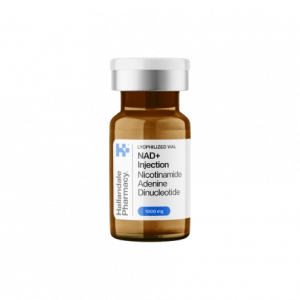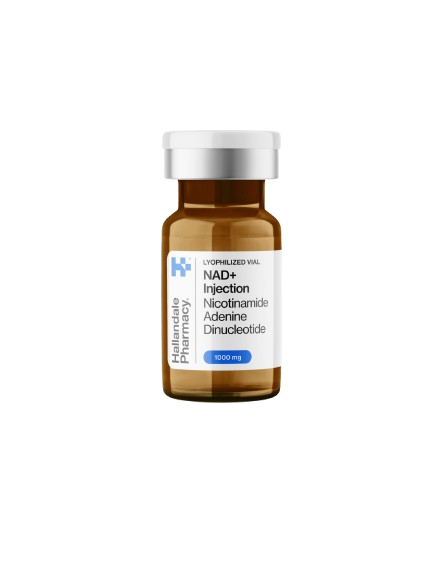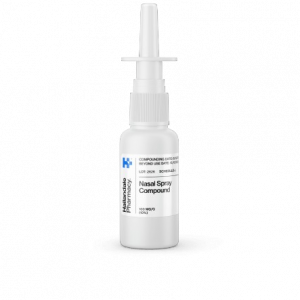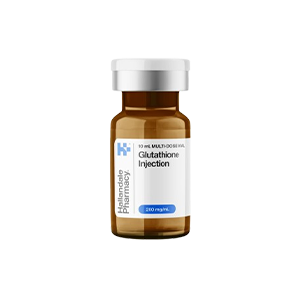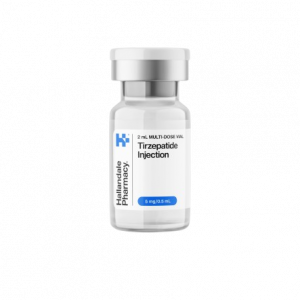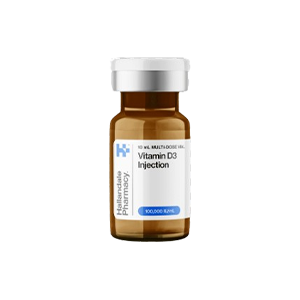NAD+ Injections: 12 weeks
$265.00
Boosts energy levels, enhances mood, restores muscle function and anti-aging
- 12 week supply
- 100mg/ml (1,000mg/10ml vial)
- Syringes and prep pads included
- Shipping included
Description
NAD+ (Nicotinamide adenine dinucleotide) injections are used as a treatment to boost the body’s energy levels, improve mental clarity, and support cellular repair. NAD+ is a coenzyme found in every cell of the body and plays a crucial role in energy production, DNA repair, and various metabolic processes.
Some proponents claim that NAD+ injections can offer benefits like:
- Enhanced energy levels – NAD+ is involved in the production of ATP, the molecule that provides energy to cells.
- Improved cognitive function – Some people use NAD+ injections to enhance mental clarity, focus, and reduce brain fog.
- Anti-aging effects – NAD+ levels decline with age, and boosting it is thought to slow down aging processes by promoting cellular repair and mitochondrial health.
- Addiction recovery support – Some research suggests NAD+ therapy may help with addiction recovery by reducing cravings and withdrawal symptoms.
- Increased metabolism – NAD+ can play a role in fat and carbohydrate metabolism, potentially helping with weight management.
NAD+ is administered as a subcutaneous injection (under the skin) 1-2 times a week.
Week 1-4: 50mg (50 units) subcutaneous injection once a week.
Week 4+: 100 mg (100 units) subcutaneous injection once a week.
Taking a subcutaneous (Sub-Q) NAD+ injection involves injecting the substance into the layer of fat just beneath your skin.
It’s important to follow proper technique to ensure the injection is done safely and effectively. Below are the general steps for administering a subcutaneous NAD+ injection.
How to Administer a Subcutaneous NAD+ Injection:
1. Gather Your Supplies Before you start, make sure you have everything you need: NAD+ solution (prepared by your healthcare provider) Syringe (with a small needle for subcutaneous injection, typically 25–30 gauge) Alcohol wipes (for sterilizing the injection site) Cotton balls or gauze Sharps container (for disposing of needles and syringes safely)
2. Wash Your Hands Clean your hands thoroughly with soap and water to reduce the risk of infection.
3. Prepare the Injection Check the NAD+ solution for clarity. It should be clear and free of particles. Never use if the solution is cloudy or discolored. If you’re drawing the NAD+ from a vial, use a sterile needle to withdraw the correct amount of NAD+. Remove any air bubbles by tapping the syringe and pushing the plunger slightly.
4. Choose the Injection Site The best sites for subcutaneous injections are areas with a layer of fatty tissue under the skin. Common areas include: The outer part of the thigh (one of the most popular sites). The abdomen (avoiding the area near the belly button). The upper arm, but this may be harder to reach on your own.
5. Clean the Injection Site Use an alcohol wipe to clean the area where you’ll be injecting. Allow the area to dry to avoid any stinging when you inject.
6. Inject the NAD+ Solution Pinch the skin around the injection site to create a “skin fold.” This helps to stabilize the needle and make the injection easier. Insert the needle at a 45–90° angle to the skin (depending on the amount of fat in the area). For people with less body fat, a 90-degree angle is usually required, while those with more body fat may inject at a shallower angle. Push the plunger slowly to inject the NAD+ solution into the fat layer. Ensure that you don’t force the plunger; if you feel resistance, try adjusting the angle of the needle.
7. Withdraw the Needle and Apply Pressure Remove the needle quickly and apply gentle pressure with a cotton ball or gauze to the injection site. You can use a small bandage if needed, especially if there’s minor bleeding. Massage the area gently to help disperse the medication and minimize discomfort.
8. Dispose of the Needle and Syringe Place the used needle and syringe in a sharps container for safe disposal. Never throw needles or syringes in the regular trash.
Tips for Subcutaneous Injections Rotate Injection Sites:
Avoid injecting in the same spot every time. This helps to prevent irritation or the development of lumps under the skin.
Practice Proper Hygiene: Always clean your hands and the injection site before administering the injection to reduce the risk of infection.
Start with a Low Dose: If you’re new to NAD+ injections, your healthcare provider may recommend starting with a smaller dose to gauge how your body reacts.
Stay Calm: If you’re nervous, take slow, deep breaths to stay relaxed. The injection is usually quick and doesn’t hurt as much as you might think.
When to Seek Medical Advice: If you experience any of the following, reach out to your healthcare provider: Signs of infection at the injection site (increased redness, swelling, warmth, pus). Severe allergic reaction symptoms (rash, difficulty breathing, swelling). Severe pain or discomfort that doesn’t subside.
Subcutaneous (Sub-Q) NAD+ injections involve injecting the substance into the layer of fat under the skin, and while this method is generally well-tolerated, there are still potential side effects. The side effects for NAD+ administered through subcutaneous injection are similar to those seen with other injection methods, but here are some specific ones to be aware of:
Common Side Effects of NAD+ Subcutaneous Injections include Injection Site Reactions:
Pain or discomfort: Mild pain or tenderness at the injection site is common.
Redness or swelling: Some people may experience swelling or redness around the area where the needle was injected.
Bruising: A small bruise can form at the injection site due to the needle puncturing the skin.
Mild Nausea or Stomach Upset: Some people may experience mild nausea or digestive discomfort after the injection. This can occur because the NAD+ is absorbed into the bloodstream and the body begins processing it.
Headaches: Some individuals may experience a mild headache after receiving a subcutaneous injection of NAD+, similar to what can occur with intravenous (IV) infusions.
Fatigue or Dizziness: A temporary feeling of fatigue or lightheadedness may occur after the injection, particularly if the dosage is on the higher end.
Flushing or Warmth: A warm sensation or a flushed face may develop as a result of the body’s response to the injection. This is generally short-lived and usually subsides quickly.
——————-
Less Common or Rare Side Effects Infection at the Injection Site: Though rare, there is a slight risk of infection at the injection site if proper hygiene is not maintained.
Signs of infection include increased redness, warmth, swelling, or pus.
Allergic Reactions: An allergic reaction to the NAD+ or any of the other components in the injection (like preservatives or saline) could occur, though this is very uncommon.
What to Do if Side Effects Occur: Mild side effects like temporary redness, swelling, or discomfort at the injection site typically resolve on their own. If the pain becomes severe or if you notice unusual symptoms, it’s important to contact a healthcare provider. Severe side effects like difficulty breathing, chest pain, or severe swelling should be treated as medical emergencies, and you should seek immediate medical attention.

